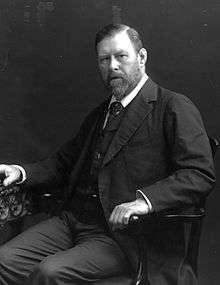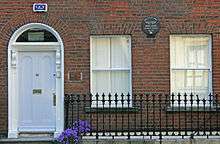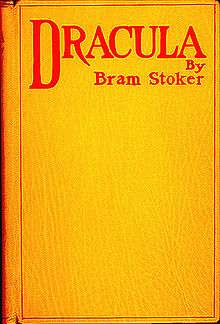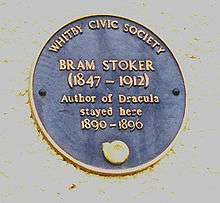Bram Stoker
| Bram Stoker | |
|---|---|
 Photograph of Bram Stoker circa 1906 | |
| Born |
Abraham Stoker 8 November 1847 Clontarf, Dublin, Ireland |
| Died |
20 April 1912 (aged 64) London, England, UK |
| Occupation | Novelist |
| Nationality | Irish |
| Citizenship | British |
| Alma mater | Trinity College Dublin |
| Period | Victorian era, Edwardian era |
| Genre | Gothic fiction, romantic fiction |
| Literary movement | Victorian |
| Notable works | Dracula |
| Spouse | Florence Balcombe (1878 – 1912, his death) |
| Children | Irving Noel Thornley Stoker |
|
| |
| Signature |
 |
| Website | |
|
www | |
Abraham "Bram" Stoker (8 November 1847 – 20 April 1912) was an Irish author, best known today for his 1897 Gothic novel Dracula. During his lifetime, he was better known as the personal assistant of actor Henry Irving and business manager of the Lyceum Theatre in London, which Irving owned.
Early life
Stoker was born on 8 November 1847 at 15 Marino Crescent, Clontarf, on the northside of Dublin, Ireland.[1] His parents were Abraham Stoker (1799–1876) from Dublin and Charlotte Mathilda Blake Thornley (1818–1901), who was raised in County Sligo.[2] Stoker was the third of seven children, the eldest of whom was Sir Thornley Stoker, 1st Bt.[3] Abraham and Charlotte were members of the Church of Ireland Parish of Clontarf and attended the parish church with their children, who were baptised there.[4]
Stoker was bedridden with an unknown illness until he started school at the age of seven, when he made a complete recovery. Of this time, Stoker wrote, "I was naturally thoughtful, and the leisure of long illness gave opportunity for many thoughts which were fruitful according to their kind in later years." He was educated in a private school run by the Rev. William Woods.[5]
After his recovery, he grew up without further serious illnesses, even excelling as an athlete (he was named University Athlete) at Trinity College, Dublin, which he attended from 1864 to 1870. He graduated with honours as a B.A. in Mathematics. He was auditor of the College Historical Society (the Hist) and president of the University Philosophical Society, where his first paper was on Sensationalism in Fiction and Society.
Early career
Stoker became interested in the theatre while a student through his friend Dr. Maunsell. He became the theatre critic for the Dublin Evening Mail, co-owned by the author of Gothic tales Sheridan Le Fanu. Theatre critics were held in low esteem, but he attracted notice by the quality of his reviews. In December 1876, he gave a favourable review of Henry Irving's Hamlet at the Theatre Royal in Dublin. Irving invited Stoker for dinner at the Shelbourne Hotel where he was staying, and they became friends. Stoker also wrote stories, and "The Crystal Cup" was published by the London Society in 1872, followed by "The Chain of Destiny" in four parts in The Shamrock. In 1876 while a civil servant in Dublin, Stoker wrote the non-fiction book The Duties of Clerks of Petty Sessions in Ireland (published 1879) which remained a standard work.[5] Furthermore, he possessed an interest in art, and was a founder of the Dublin Sketching Club in 1879
Lyceum Theatre

In 1878 Stoker married Florence Balcombe, daughter of Lieutenant-Colonel James Balcombe of 1 Marino Crescent. She was a celebrated beauty whose former suitor was Oscar Wilde.[6] Stoker had known Wilde from his student days, having proposed him for membership of the university’s Philosophical Society while he was president. Wilde was upset at Florence's decision, but Stoker later resumed the acquaintanceship, and after Wilde's fall visited him on the Continent.[7]

The Stokers moved to London, where Stoker became acting manager and then business manager of Irving's Lyceum Theatre, London, a post he held for 27 years. On 31 December 1879, Bram and Florence's only child was born, a son whom they christened Irving Noel Thornley Stoker. The collaboration with Henry Irving was important for Stoker and through him he became involved in London's high society, where he met James Abbott McNeill Whistler and Sir Arthur Conan Doyle (to whom he was distantly related). Working for Irving, the most famous actor of his time, and managing one of the most successful theatres in London made Stoker a notable if busy man. He was dedicated to Irving and his memoirs show he idolised him. In London Stoker also met Hall Caine, who became one of his closest friends – he dedicated Dracula to him.
In the course of Irving's tours, Stoker travelled the world, although he never visited Eastern Europe, a setting for his most famous novel. Stoker enjoyed the United States, where Irving was popular. With Irving he was invited twice to the White House, and knew William McKinley and Theodore Roosevelt. Stoker set two of his novels there, using Americans as characters, the most notable being Quincey Morris. He also met one of his literary idols, Walt Whitman.
Writings

Stoker visited the English town of Whitby in 1890, and that visit is said to be part of the inspiration of his great novel Dracula. He began writing novels while manager for Henry Irving and secretary and director of London's Lyceum Theatre, beginning with The Snake's Pass in 1890 and Dracula in 1897. During this period, Stoker was part of the literary staff of the The Daily Telegraph in London, and he wrote other fiction, including the horror novels The Lady of the Shroud (1909) and The Lair of the White Worm (1911).[8] He published his Personal Reminiscences of Henry Irving in 1906, after Irving's death, which proved successful,[5] and managed productions at the Prince of Wales Theatre.
Before writing Dracula, Stoker met Ármin Vámbéry, a Hungarian writer and traveller. Dracula likely emerged from Vámbéry's dark stories of the Carpathian mountains.[9] Stoker then spent several years researching European folklore and mythological stories of vampires.
Dracula is an epistolary novel, written as a collection of realistic but completely fictional diary entries, telegrams, letters, ship's logs, and newspaper clippings, all of which added a level of detailed realism to the story, a skill which Stoker had developed as a newspaper writer. At the time of its publication, Dracula was considered a "straightforward horror novel" based on imaginary creations of supernatural life.[8] "It gave form to a universal fantasy . . . and became a part of popular culture."[8]
According to the Encyclopedia of World Biography, Stoker's stories are today included in the categories of "horror fiction", "romanticized Gothic" stories, and "melodrama."[8] They are classified alongside other "works of popular fiction" such as Mary Shelley's Frankenstein,[10]:394 which also used the "myth-making" and story-telling method of having multiple narrators telling the same tale from different perspectives, according to historian Jules Zanger. "'They can't all be lying,' thinks the reader."[11]
The original 541-page typescript of Dracula was believed to have been lost until it was found in a barn in northwestern Pennsylvania in the early 1980s.[12] It consisted of typed sheets with many emendations, plus handwritten on the title page was "THE UN-DEAD." The author's name was shown at the bottom as Bram Stoker. Author Robert Latham remarked: "the most famous horror novel ever published, its title changed at the last minute."[10] The typescript was purchased by Microsoft co-founder Paul Allen.
Stoker's inspirations for the story, in addition to Whitby, may have included a visit to Slains Castle in Aberdeenshire, a visit to the crypts of St. Michan's Church in Dublin, and the novella Carmilla by Sheridan Le Fanu.[13]
Stoker's original research notes for the novel are kept by the Rosenbach Museum and Library in Philadelphia, PA. A facsimile edition of the notes was created by Elizabeth Miller and Robert Eighteen-Bisang in 1998.
Death
_002.jpg)
After suffering a number of strokes, Stoker died at No. 26 St George's Square on 20 April 1912.[14] Some biographers attribute the cause of death to tertiary syphilis,[15] others to overwork.[16] He was cremated, and his ashes were placed in a display urn at Golders Green Crematorium. After the death of Stoker's son, Irving Noel Stoker in 1961, Irving's ashes were added to that urn. The original plan had been to keep his parents' ashes together, but after Florence Stoker's death, her ashes were scattered at the Gardens of Rest. Visitors to Stoker's urn at Golders Green are escorted to the room as a precaution against vandalism.
Beliefs and philosophy
Stoker was raised a Protestant in the Church of Ireland. He was a strong supporter of the Liberal Party and took a keen interest in Irish affairs.[5] As a "philosophical home ruler," he supported Home Rule for Ireland brought about by peaceful means. He remained an ardent monarchist who believed that Ireland should remain within the British Empire, an entity that he saw as a force for good. He was an admirer of Prime Minister William Ewart Gladstone, whom he knew personally, and supported his plans for Ireland.[17]
Stoker believed in progress and took a keen interest in science and science-based medicine. Some Stoker novels represent early examples of science fiction, such as The Lady of the Shroud (1909). He had a writer's interest in the occult, notably mesmerism, but despised fraud and believed in the superiority of the scientific method over superstition. Stoker counted among his friends J. W. Brodie-Innis, a member of the Hermetic Order of the Golden Dawn, and hired member Pamela Colman Smith as an artist for the Lyceum Theatre, but no evidence suggests that Stoker ever joined the Order himself.[18][19][20]
Posthumous
The short story collection Dracula's Guest and Other Weird Stories was published in 1914 by Stoker's widow, Florence Stoker, who was also his literary executrix. The first film adaptation of Dracula was F. W. Murnau's Nosferatu, released in 1922, with Max Schreck starring as Count Orlock. Florence Stoker eventually sued the filmmakers, and was represented by the attorneys of the British Incorporated Society of Authors. Her chief legal complaint was that she had neither been asked for permission for the adaptation nor paid any royalty. The case dragged on for some years, with Mrs. Stoker demanding the destruction of the negative and all prints of the film. The suit was finally resolved in the widow's favour in July 1925. A single print of the film survived, however, and it has become well known. The first authorised film version of Dracula did not come about until almost a decade later when Universal Studios released Tod Browning's Dracula starring Bela Lugosi.
Canadian writer Dacre Stoker, a great-grandnephew of Bram Stoker, decided to write "a sequel that bore the Stoker name" to "reestablish creative control over" the original novel, with encouragement from screenwriter Ian Holt, because of the Stokers' frustrating history with Dracula's copyright. In 2009, Dracula: The Un-Dead was released, written by Dacre Stoker and Ian Holt. Both writers "based [their work] on Bram Stoker's own handwritten notes for characters and plot threads excised from the original edition" along with their own research for the sequel. This also marked Dacre Stoker's writing debut.[21][22]
In Spring 2012, Dacre Stoker (in collaboration with Prof. Elizabeth Miller) presented the "lost" Dublin Journal written by Bram Stoker, which had been kept by his great-grandson Noel Dobbs. Stoker's diary entries shed a light on the issues that concerned him before his London years. A remark about a boy who caught flies in a bottle might be a clue for the later development of the Renfield character in Dracula.[23]
On 8 November 2012, Stoker was honoured with a Google Doodle on Google's homepage commemorating his 165th birthday.[24][25]
An annual festival takes place in Dublin, the birthplace of Bram Stoker, in honour of his literary achievements. The 2014 Bram Stoker Festival encompassed literary, film, family, street, and outdoor events, and ran from 24–27 October in and around Dublin City.[26][27] The festival is supported by the Bram Stoker Estate[28] and funded by Dublin City Council and Fáilte Ireland.
Bibliography
Novels
- The Snake's Pass (1890)
Seven Golden Buttons (1891)
- The Watter's Mou' (1895)
- The Shoulder of Shasta (1895)
- Dracula (1897)
- Miss Betty (1898)
- The Mystery of the Sea (1902)
- The Jewel of Seven Stars (1903)
- The Man (a.k.a. The Gates of Life) (1905)
- Lady Athlyne (1908)
- The Lady of the Shroud (1909)
- The Lair of the White Worm (a.k.a. The Garden of Evil) (1911)
Short story collections
- Under the Sunset (1881), comprising eight fairy tales for children.
- Snowbound: The Record of a Theatrical Touring Party (1908)
- Dracula's Guest and Other Weird Stories (1914)
Uncollected stories
| Title | Date of earliest appearance | Earliest appearance | Novelisation |
|---|---|---|---|
| "The Crystal Cup" | xx/09/1872 | London Society (London) | |
| "Buried Treasures" | 13 March 1875 and 20 March 1875 | The Shamrock (Dublin) | |
| "The Chain of Destiny" | 1 May 1875 and 22 May 1875 | The Shamrock (Dublin) | |
| "Our New House" | 20 December 1895 | Boston Herald (Boston) | |
| "The Dualitists; or, The Death Doom of the Double Born" | xx/xx/1887 | The Theatre Annual (London) | |
| "The Gombeen Man" | xx/xx/1889 – xx/xx/1890 | The People (London) | Chapter 3 of The Snake's Pass |
| "The Night of the Shifting Bog" | xx/01/1891 | Current Literature: A Magazine of Record and Review Vol. VI. No. 1. (New York) | |
| "Lord Castleton Explains" | 30 January 1892 | The Gentlewoman: The Illustrated Weekly Journal for Gentlewomen (London) | Chapter 10 of The Fate of Fenella (Hutchinson, 1892) |
| "Old Hogen: A Mystery" | xx/xx/1893 | ||
| "The Man from Shorrox'" | xx/02/1894 | The Pall Mall Magazine (London) | |
| "The Red Stockade" | xx/09/1894 | The Cosmopolitan: An Illustrated Monthly Magazine (London) | |
| "When the Sky Rains Gold" | xx/xx/1894 | ||
| "At the Watter's Mou'" | xx/11/1895 | Current Literature: A Magazine of Record and Review Vol. XVIII. No. 5. (New York) | |
| "Bengal Roses" | xx/xx/1898 | ||
| "A Yellow Duster" | 7 May 1899 | Lloyd's Weekly Newspaper (London) | |
| "A Young Widow" | xx/xx/1899 | ||
| "A Baby Passenger" | xx/xx/1899 | ||
| "Lucky Escapes of Sir Henry Irving" | xx/xx/1890 | ||
| "The Seer" | xx/xx/1902 | The Mystery of the Sea (New York: Doubleday, Page & Co) | Chapters 1 and 2 of The Mystery of the Sea |
| "The Bridal of Death" | xx/xx/1903 | The Jewel of the Seven Stars (London: William Heinemann) | Alternate ending to The Jewel of Seven Stars |
| "What They Confessed: A Low Comedian's Story" | xx/xx/1908 | ||
| "The Way of Peace" | xx/xx/1909 | Everybody's Story Magazine (London) | |
| "The 'Eroes of the Thames" | xx/10/1908 | The Royal Magazine (London) | |
| "Greater Love" | xx/10/1914 | The London Magazine (London) |
Non-fiction
- The Duties of Clerks of Petty Sessions in Ireland (1879)
- A Glimpse of America (1886)
- Personal Reminiscences of Henry Irving (1906)
- Famous Impostors (1910)
- Bram Stoker's Notes for Dracula: A Facsimile Edition (2008) Bram Stoker Annotated and Transcribed by Robert Eighteen-Bisang and Elizabeth Miller, Foreword by Michael Barsanti. Jefferson NC & London: McFarland. ISBN 978-0-7864-3410-7
Articles
- "The Question of a National Theatre" The Nineteenth Century and After, Vol. LXIII, January/June 1908.
- "Mr. De Morgan's Habits of Work" The World's Work, Vol. XVI, May/October 1908.
- "The Censorship of Fiction" The Nineteenth Century and After, Vol. LXIV, July/December 1908.
- "The Censorship of Stage Plays" The Nineteenth Century and After, Vol. LXVI, July/December 1909.
- "Irving and Stage Lightning" The Nineteenth Century and After, Vol. LXIX, January/June 1911.
Critical works on Stoker
- William Hughes, Beyond Dracula (Palgrave, 2000) ISBN 0-312-23136-9[29]
- Belford, Barbara. Bram Stoker: A Biography of the Author of Dracula. London: Weidenfeld and Nicolson, 1996.
- Senf, Carol. Science and Social Science in Bram Stoker's Fiction (Greenwood, 2002).
- Senf, Carol. Dracula: Between Tradition and Modernism (Twayne, 1998).
- Senf, Carol A. Bram Stoker (University of Wales Press, 2010).
Bibliographies
- William Hughes Bram Stoker – Victorian Fiction Research Guide
References
- ↑ Belford, Barbara (2002). Bram Stoker and the Man Who Was Dracula. Cambridge, Mass.: Da Capo Press. p. 17. ISBN 0-306-81098-0.
- ↑ Murray, Paul (2004). From the Shadow of Dracula: A Life of Bram Stoker. Random House. p. 11. ISBN 0224044621.
- ↑ His siblings were: Sir (William) Thornley Stoker, born in 1845; Mathilda, born 1846; Thomas, born 1850; Richard, born 1852; Margaret, born 1854; and George, born 1855
- ↑ http://www.eneclann.ie/wp-content/uploads/2012/04/Stoker-family-tree.pdf
- 1 2 3 4 Obituary, Irish Times, 23 April 1912
- ↑ Irish Times, 8 March 1882, page 5
- ↑ "Why Dracula never loses his bite". Irish Times. 28 March 2009.
- 1 2 3 4 Encyclopedia of World Biography, Gale Research (1998) vol 8. pgs. 461–464
- ↑ "Vampires - Top 10 Famous Mysterious Monsters - TIME". TIME.com. 14 August 2009.
- 1 2 Latham, Robert. Science Fiction & Fantasy Book Review Annual, Greenwood Publishing (1988) p. 67
- ↑ Zanger, Jules. Blood Read: The Vampire as Metaphor in Contemporary Culture ed. Joan Gordon. Univ. of Pennsylvania Press (1997), pgs. 17–24
- ↑ John J. Miller (28 October 2008). "What a Tax Lawyer Dug Up on 'Dracula'". WSJ.
- ↑ Boylan, Henry (1998). A Dictionary of Irish Biography, 3rd Edition. Dublin: Gill and MacMillan. p. 412. ISBN 0-7171-2945-4.
- ↑ "Bram Stoker". Victorian Web. 30 April 2008. Retrieved 12 December 2008.
- ↑ Gibson, Peter (1985). The Capital Companion. Webb & Bower. pp. 365–366. ISBN 0-86350-042-0.
- ↑ The Discussion (Third ed.). Grade Eight – Bram Stoker: Oberon Books (for The London Academy of Music and Dramatic Arts). 2004. p. 97. ISBN 1-84002-431-3.
- ↑ Murray, Paul. From the Shadow of Dracula: A Life of Bram Stoker. 2004.
- ↑ "Shadowplay Pagan and Magick webzine – HERMETIC HORRORS". Shadowplayzine.com. 16 September 1904. Archived from the original on 9 November 2009. Retrieved 18 June 2012.
- ↑ Ravenscroft, Trevor (1982). The occult power behind the spear which pierced the side of Christ. Red Wheel. p. 165. ISBN 0-87728-547-0.
- ↑ Picknett, Lynn (2004). The Templar Revelation: Secret Guardians of the True Identity of Christ. Simon and Schuster. p. 201. ISBN 0-7432-7325-7.
- ↑ Dracula: The Un-Dead by Dacre Stoker and Ian Holt
- ↑ Dracula: The Undead's overview
- ↑ Stoker, Bram. Bram Stoker’s Lost Dublin Journal, ed. by Stoker, Dacre and Miller, Elizabeth. London: Biteback Press, 2012
- ↑ "Bram Stoker's 165th Birthday".
- ↑ Doyle, Carmel (8 November 2012). "Bram Stoker books: gothic Google Doodle honours Dracula author". Silicon Republic. Retrieved 8 November 2012.
- ↑ "Bram Stoker Festival - 28-31 Oct 2016 - Day & Night Events". Bram Stoker Festival 2015.
- ↑ "What's on in Dublin - Dublin Events, Festivals, Concerts, Theatre, family events - Visit Dublin".
- ↑ "The Bram Stoker Festival in Dublin- 2013 Events".
- ↑ http://muse.jhu.edu/login?uri=/journals/victorian_studies/v044/44.2glover.html
External links
| Library resources about Bram Stoker |
| Wikiquote has quotations related to: Bram Stoker |
| Wikimedia Commons has media related to Bram Stoker. |
| Wikisource has original works written by or about: Bram Stoker |
- Works by Bram Stoker at Project Gutenberg
- Works by or about Bram Stoker at Internet Archive
- Works by Bram Stoker at LibriVox (public domain audiobooks)

- Works by Bram Stoker at Open Library

- Bram Stoker at DMOZ
- Bram Stoker at the Internet Movie Database
- h2g2 article on Bram Stoker
- Bram Stoker's brief biography and works
- 20 Common Misconceptions and Other Miscellaneous Information
- Gothic and Stoker Studies at Bath Spa University
- Bram Stoker Full text and PDF versions of most of Stoker's works.
- Bram Stoker's Dracula Full text of Stoker's novel Dracula.
- "Bram Stoker". Find a Grave. Retrieved 8 February 2014.
- Short presentation of Bram Stoker's boyhood neighbourhood in Dublin
- Bram Stoker at the Internet Speculative Fiction Database
- Bram Stoker at Library of Congress Authorities, with 210 catalogue records